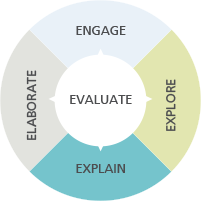When developing educational activities, it is recommended that you base these on the 5E model. It is furthermore recommended that the eventual activity is designed in a way that allows teachers to follow and use this 5E model as far as possible.
The 5E Model Explained
Much research has been done on what yields good learning and on what the pupil has gained when the lesson is over. It is difficult to draw categorical conclusions, because there are so many variables in a learning situation. Moreover, pupils differ greatly and have different learning aptitudes. Much of the research, however, points out that pupil-active teaching, when followed up with reflection, application, recapitulation and continuous assessment, yields good results. Pupils must be motivated and involved, and teaching must be based on the pupil’s prior knowledge. Furthermore, pupils should have the opportunity to explore, explain and extend their knowledge and understanding. Continual assessment (formative assessment) is recommended as an integrated part of teaching, and expectations should be placed on the pupils (‘learning pressure’). In addition, it appears that variation in both teaching methods and learning arenas is important for pupil motivation and hence learning.
The 5E model is a tool to support teachers in the planning, implementation and evaluation of learning for the actively participating pupil. It is also a tool to support you as a developer in designing and implementing the activity, as well as a tool that is very useful when evaluators test and evaluate the activity.
It is called the 5E model simply because all five pedagogical concepts start with the letter E: engage, explore, explain, elaborate, evaluate. This means:

Engaging: motivation, need for learning, use prior knowledge
Explore: allow the pupils to investigate, take decisions, search and collect information, vary methods, practical activities, group work and individual work
Explaining: allow the pupils to communicate their knowledge, introduce new concepts
Elaborating: what do we know? How can we learn more? Knowledge in new contexts
Evaluating: self-evaluation, reflection, assessment, feedback, learning outcomes
Evaluation at the centre
The word ‘evaluate’ is placed in the centre of the model because the purpose of the evaluation is to promote learning, and because evaluation occurs in all phases of teaching. The term evaluation covers three types of assessment: continuous evaluation (formative assessment), final evaluation (summative assessment) and self-assessment.
Evaluations must be conducted continuously, be varied, and be a natural part of the instruction given, whether orally or in writing. The pupils should evaluate their own learning and understanding, as well as the quality of their own work. The teacher in turn should evaluate the pupils’ learning in relation to the learning outcomes.
The evaluation should show whether the pupils have attained the desired outcome, e.g. gained the right knowledge, skills, behaviour and/or attitudes. It thereby provides important feedback that supports the pupils’ learning, as it also allows for appropriate action to be taken if this is found not to be the case.
Encourage the use of the 5E Model in your design
When you are designing an activity, make sure that the activity itself encourages the teacher to use the 5E model as a tool for reflection to develop, plan, implement and evaluate teaching sessions (e.g. lessons). It does not mean that you cannot give a lecture as an activity; however, by understanding and applying the principles of this model, you are more likely to succeed in giving children the possibility to be engaged and to explore, explain, elaborate and evaluate themselves – both as a process and as a result. The 5E model can furthermore be used for both long-term planning as well as planning individual lessons.
A checklist on applying the 5E model can be found in this example, which will help you ensure that your activity encourages the use of the 5E model.
Encourage the use of the 5E Model in the testing and evaluation of your activity
Encourage the evaluators to use the 5E model as a tool when testing and evaluating your activity. Using the 5E model will help the evaluators determine whether the activity is successful in engaging the pupils and make them explore, explain, elaborate and evaluate.
More Information
LEARN! Manual Example #1. This example shows how all the steps can be applied in the development, implementation and evaluation of an activity. It also shows how the 5E model can be applied to an activity’s design.
LEARN! Manual Example #9: Applying the 5E Model when Designing a (Digital) Learning Experience.
LEARN! Manual Example #12: Pre-Testing a New Version of a Cycling test.
Trygg Trafikk (2017), The Norwegian Council for Road Safety’s model for behaviour modification.
Key Principle #13 Example: Student Assessment as part of the 5E Model